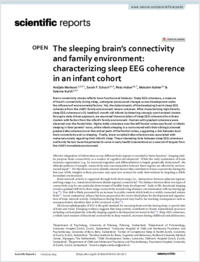The sleeping brain’s connectivity and family environment: characterizing sleep EEG coherence in an infant cohort
PSPE
- Markovic, Andjela ORCID Department of Psychology, University of Fribourg, Fribourg, Switzerland; Department of Pulmonology, University Hospital Zurich, Zurich, Switzerland; University Hospital of Child and Adolescent Psychiatry and Psychotherapy, University of Bern, Bern, Switzerland
- Schoch, Sarah F. Department of Pulmonology, University Hospital Zurich, Zurich, Switzerland; Center of Competence Sleep & Health Zurich, University of Zurich, Zurich, Switzerland; Donders Institute for Brain, Cognition and Behaviour, Radboud University Medical Centre, Nijmegen, The Netherlands
- Huber, Reto Center of Competence Sleep & Health Zurich, University of Zurich, Zurich, Switzerland; Child Development Center, University Children’s Hospital Zurich, Zurich, Switzerland; Department of Child and Adolescent Psychiatry and Psychotherapy, Psychiatric Hospital, University of Zurich, Zurich, Switzerland
- Kohler, Malcolm Department of Pulmonology, University Hospital Zurich, Zurich, Switzerland; Center of Competence Sleep & Health Zurich, University of Zurich, Zurich, Switzerland
- Kurth, Salome ORCID Department of Psychology, University of Fribourg, Fribourg, Switzerland; Department of Pulmonology, University Hospital Zurich, Zurich, Switzerland; Center of Competence Sleep & Health Zurich, University of Zurich, Zurich, Switzerland
- 04.02.2023
Published in:
- Scientific Reports. - Springer Science and Business Media LLC. - 2023, vol. 13, no. 2055, p. 1-11
English
Brain connectivity closely refects brain function and behavior. Sleep EEG coherence, a measure of brain’s connectivity during sleep, undergoes pronounced changes across development under the infuence of environmental factors. Yet, the determinants of the developing brain’s sleep EEG coherence from the child’s family environment remain unknown. After characterizing high-density sleep EEG coherence in 31 healthy 6-month-old infants by detecting strongly synchronized clusters through a data-driven approach, we examined the association of sleep EEG coherence from these clusters with factors from the infant’s family environment. Clusters with greatest coherence were observed over the frontal lobe. Higher delta coherence over the left frontal cortex was found in infants sleeping in their parents’ room, while infants sleeping in a room shared with their sibling(s) showed greater delta coherence over the central parts of the frontal cortex, suggesting a link between local brain connectivity and co-sleeping. Finally, lower occipital delta coherence was associated with maternal anxiety regarding their infant’s sleep. These interesting links between sleep EEG coherence and family factors have the potential to serve in early health interventions as a new set of targets from the child’s immediate environment.
- Faculty
- Faculté des lettres et des sciences humaines
- Department
- Département de Psychologie
- Language
-
- English
- Classification
- Psychology
- License
- CC BY
- Open access status
- gold
- Identifiers
-
- DOI 10.1038/s41598-023-29129-3
- ISSN 2045-2322
- Persistent URL
- https://folia.unifr.ch/unifr/documents/324524
Other files
Statistics
Document views: 40
File downloads:
- markovic_et_al-2023-infantsleepeegcoherence-scientific_reports.pdf: 124
- Supplementary Methods_Markovic_230123.pdf: 51

